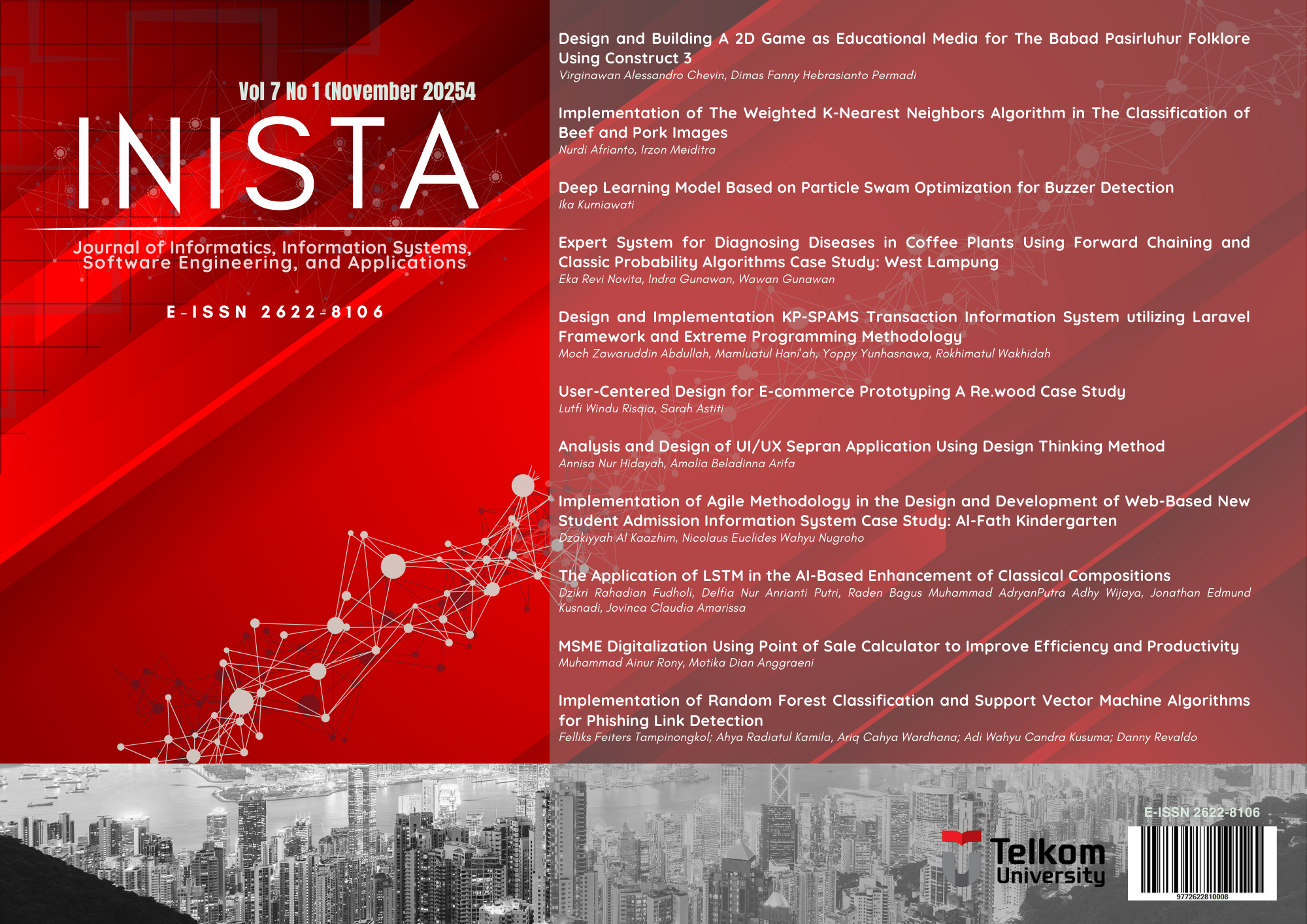Analysis and Design of UI/UX Sepran Application Using Design Thinking Method
Main Article Content
Abstract
Abstract
Finance is something that must be thought about from a broader perspective. A low level of financial literacy can result in individuals making financial decisions using only speculation, not according to financial analysis sourced from historical data. If the decision taken turns out to be wrong or inappropriate, it will have an impact on financial health in the future. This statement can be overcome by using several financial management applications that provide features to view historical financial expenses and income in a certain period, one of which is the Sepran application: Expenses Manager. However, this Sepran application still has several shortcomings, such as not being able to connect to an e-wallet so that it can only be input manually, the font size and some icons that still look small, and the colours used in expenses. From these problems, a redesign of the Sepran application will be carried out using the design thinking method approach and the System Usability Scale (SUS) to measure the success rate of the designed interface. Design thinking has 5 stages, namely Empathize, Define, Ideate, Prototype, and Test. The first stage, empathize, is the stage of extracting problems. Define is the stage of defining problems, and ideate is the stage of determining ideas from problems that have been defined at the ideate stage. Furthermore, the prototype is a stage where ideas that have been determined at the ideate stage are implemented into low- and high-fidelity designs. The last is the test stage, where this stage will test using SUS through a prototype to get feedback and find out whether the design objectives have been achieved. The purpose of this research is to redesign the Sepran application to meet user needs and analyze the success rate of the interface using SUS. The results obtained an average score of 93.25 and a grade of A. This score indicates that the redesign of the Sepran application is in accordance with user needs.
Article Details

This work is licensed under a Creative Commons Attribution-ShareAlike 4.0 International License.
Authors who publish with this journal agree to the following terms:
- Authors retain copyright and grant the journal right of first publication with the work simultaneously licensed under a Creative Commons Attribution License (CC BY-SA 4.0) that allows others to share the work with an acknowledgement of the work's authorship and initial publication in this journal.
- Authors are able to enter into separate, additional contractual arrangements for the non-exclusive distribution of the journal's published version of the work (e.g., post it to an institutional repository or publish it in a book), with an acknowledgement of its initial publication in this journal.
- Authors are permitted and encouraged to post their work online (e.g., in institutional repositories or on their website) prior to and during the submission process, as it can lead to productive exchanges, as well as earlier and greater citation of published work.
References
[2] M. Multazam, “Perancangan User Interface dan User Experience pada Placeplus menggunakan pendekatan User Centered Design,” Univ. Islam Indones., vol. 1, p. 8, 2020, [Online]. Available: https://journal.uii.ac.id/AUTOMATA/article/view/15528/10233
[3] H. A. Ramadhan and G. F. Fitriana, “Desain Aplikasi Seluler untuk Menemukan Tempat Magang Menggunakan metode Design Thinking,” vol. 16, no. 1, pp. 162–174, 2022.
[4] S. S. Rosyda and I. Sukoco, “Model Design Thinking pada Perancangan Aplikasi Matengin Aja,” Organum J. Saintifik Manaj. dan Akunt., vol. 3, no. 1, pp. 1–12, 2020, doi: 10.35138/organum.v3i1.69.
[5] Z. Zakiya Maulidia and R. Andrian, “Perancangan Website Majalengka Saber Hoaks dalam Mendukung Proses Verifikasi Informasi dengan Menggunakan Metode Design Thinking The Design of Majalengka Saber Hoaks Website in Supporting the Information Verification Process Using Design Thinking Method,” J. Teknol. dan Inf., vol. 13, pp. 17–28, 2023, doi: 10.34010/jati.v13i1.
[6] R. Maulina, A. Dumyati, S. Wahyuni, I. I. Hidayat, R. Sataria, and M. R. Pribadi, “Pembuatan User Interface Layanan Aplikasi Komik Online Menggunakan Metode Perancangan Design Thinking,” MDP Student, pp. 413–420, 2022, [Online]. Available: https://jurnal.mdp.ac.id/index.php/msc/article/view/1792
[7] Irwansyah, D. Juardi, and R. Ardian, “Penerapan Metode Design Thinking Pada Model Perancangan UI Dan UX Aplikasi Keuangan Berbasis Mobile,” J. Ilm. Wahana Pendidikan, Mei, vol. 2023, no. 10, pp. 80–91, 2023, [Online]. Available: https://doi.org/10.5281/zenodo.7983315
.jpg)

